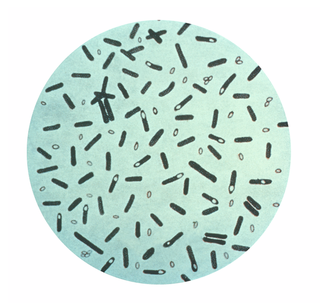
Clostridium botulinum is a Gram-positive, rod-shaped, anaerobic, spore-forming, motile bacterium with the ability to produce the neurotoxin botulinum.
An anaerobic organism or anaerobe is any organism that does not require molecular oxygen for growth. It may react negatively or even die if free oxygen is present. In contrast, an aerobic organism (aerobe) is an organism that requires an oxygenated environment. Anaerobes may be unicellular or multicellular. Most fungi are obligate aerobes, requiring oxygen to survive. However, some species, such as the Chytridiomycota that reside in the rumen of cattle, are obligate anaerobes; for these species, anaerobic respiration is used because oxygen will disrupt their metabolism or kill them. Deep waters of the ocean are a common anoxic environment.

Clostridium is a genus of anaerobic, Gram-positive bacteria. Species of Clostridium inhabit soils and the intestinal tract of animals, including humans. This genus includes several significant human pathogens, including the causative agents of botulism and tetanus. It also formerly included an important cause of diarrhea, Clostridioides difficile, which was reclassified into the Clostridioides genus in 2016.

The Clostridiaceae are a family of the bacterial class Clostridia, and contain the genus Clostridium.

Bacillus coagulans is a lactic acid–forming bacterial species first isolated and described in 1915 by B.W. Hammer at the Iowa Agricultural Experiment Station as a cause of an outbreak of coagulation in evaporated milk packed by an Iowa condensary. Separately isolated in 1935 and described as Lactobacillus sporogenes in the fifth edition of Bergey's Manual of Systematic Bacteriology, it exhibits characteristics typical of both genera Lactobacillus and Bacillus; its taxonomic position between the families Lactobacillaceae and Bacillaceae was often debated. However, in the seventh edition of Bergey's, it was finally transferred to the genus Bacillus. DNA-based technology was used in distinguishing between the two genera of bacteria, which are morphologically similar and possess similar physiological and biochemical characteristics.
Acidogenesis is the second stage in the four stages of anaerobic digestion:
Microbial collagenase is an enzyme. This enzyme catalyses the following chemical reaction

Butanol may be used as a fuel in an internal combustion engine. It is more similar to gasoline than it is to ethanol. A C4-hydrocarbon, butanol is a drop-in fuel and thus works in vehicles designed for use with gasoline without modification. Both n-butanol and isobutanol have been studied as possible fuels. Both can be produced from biomass (as "biobutanol" ) as well as from fossil fuels (as "petrobutanol"). The chemical properties depend on the isomer (n-butanol or isobutanol), not on the production method.
Butyrivibrio is a genus of bacteria in Class Clostridia. Bacteria of this genus are common in the gastrointestinal systems of many animals. Genus Butyrivibrio was first described by Bryant and Small (1956) as anaerobic, butyric acid-producing, curved rods. Butyrivibrio cells are small, typically 0.4 – 0.6 µm by 2 – 5 µm. They are motile, using a single polar or subpolar monotrichous flagellum. They are commonly found singly or in short chains but it is not unusual for them to form long chains. Despite historically being described as Gram-negative, their cell walls contain derivatives of teichoic acid, and electron microscopy indicates that bacteria of this genus have a Gram-positive cell wall type. It is thought that they appear Gram-negative when Gram stained because their cell walls thin to 12 to 18 nm as they reach stationary phase.
Hathewaya histolytica is a species of bacteria found in feces and the soil. It is a motile, gram-positive, aerotolerant anaerobe. H. histolytica is pathogenic in many species, including guinea pigs, mice, and rabbits, and humans. H. histolytica has been shown to cause gas gangrene, often in association with other bacteria species.
Enterocloster clostridioformis, formerly known as Clostridium clostridioforme, is an anaerobic, motile, Gram-positive bacterium.

Clostridium sporogenes is a species of Gram-positive bacteria that belongs to the genus Clostridium. Like other strains of Clostridium, it is an anaerobic, rod-shaped bacterium that produces oval, subterminal endospores and is commonly found in soil. Unlike Clostridium botulinum, it does not produce the botulinum neurotoxins. In colonized animals, it has a mutualistic rather than pathogenic interaction with the host.
Lacrimispora indolis is a Gram-positive, motile, anaerobic, rod-shaped bacteria that produces terminal spores. Lacrimispora indolis was originally named for its ability to hydrolyze tryptophan to indole, pyruvate, and ammonia in the classic indole test which is used to distinguish bacterial species. It is commonly found in soil and can be found in human and bird feces. Colonies of Clostridium indolis are found to be non-hemolytic and have an optimal growth temperature of 37 °C, classifying them as mesophiles.
Methanogens are a group of microorganisms that produce methane as a byproduct of their metabolism. They play an important role in the digestive system of ruminants. The digestive tract of ruminants contains four major parts: rumen, reticulum, omasum and abomasum. The food with saliva first passes to the rumen for breaking into smaller particles and then moves to the reticulum, where the food is broken into further smaller particles. Any indigestible particles are sent back to the rumen for rechewing. The majority of anaerobic microbes assisting the cellulose breakdown occupy the rumen and initiate the fermentation process. The animal absorbs the fatty acids, vitamins and nutrient content on passing the partially digested food from the rumen to the omasum. This decreases the pH level and initiates the release of enzymes for further breakdown of the food which later passes to the abomasum to absorb remaining nutrients before excretion. This process takes about 9–12 hours.
Lacrimispora algidixylanolyticum is an obligately anaerobic, psychrotolerant, xylan-degrading and spore-forming bacterium from the genus of Lacrimispora which has been isolated from vacuum packed lamb in New Zealand.
Lacrimispora amygdalinum is a Gram-positive, anaerobic and rod-shaped bacterium from the genus Lacrimispora which has been isolated from sludge from a wastewater treatment plant in the Netherlands.
Lacrimispora celerecrescens is a bacterium from the genus Lacrimispora.
Hungatella xylanolytica is a xylanolytic bacterium from the genus of Hungatella.
Butyrivibrio proteoclasticus is a bacterium from the family Lachnospiraceae originally described in the genus Clostridium.



